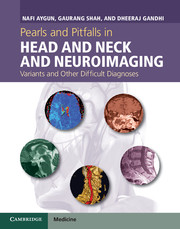Imaging description
The spectrum of chronic sinusitis is wide and includes diverse etiologies such as pyogenic, allergic, and fungal. In patients with a known history of allergies and with sinonasal polyposis, the body’s immune system responds to the presence of fungal elements within the paranasal sinus infection, leading to overproduction of eosinophilic mucin [1]. This is generally seen in immunocompetent, non-diabetic, and otherwise healthy populations. It is most commonly seen in young male adults in warm and humid climates.
On CT, there is opacification and expansion of multiple paranasal sinuses containing a centrally high-attenuating dense material (Fig. 68.1). On MRI, a central variable T1 and low T2 signal representing eosinophilic mucous is surrounded by low T1 and high T2 signal of the thickened mucosa (Fig. 68.2) [2,3]. The signal may be so low on T2-weighted images that it can mimic air (Fig. 68.2B).
Importance
The clinical spectrum of chronic rhinosinusitis represents diverse etiologies. Making the correct diagnosis of allergic fungal sinusitis allows for more accurate treatment options for this condition, including surgical resection and debridement.
Typical clinical scenario
The presence of chronic rhinosinusitis with nasal discharge and congestion, headaches, fever, and facial pain and pressure is common. The maxillary sinus is the most commonly involved sinus. The pain may be infraorbital or periauricular. Involvement of frontal sinus results in headache of forehead and supraorbital region. A history of allergies and underlying nasal polyp is common in these patients. In severe cases with bony remodeling and orbital complications, facial deformity, proptosis, and diplopia can be seen.
